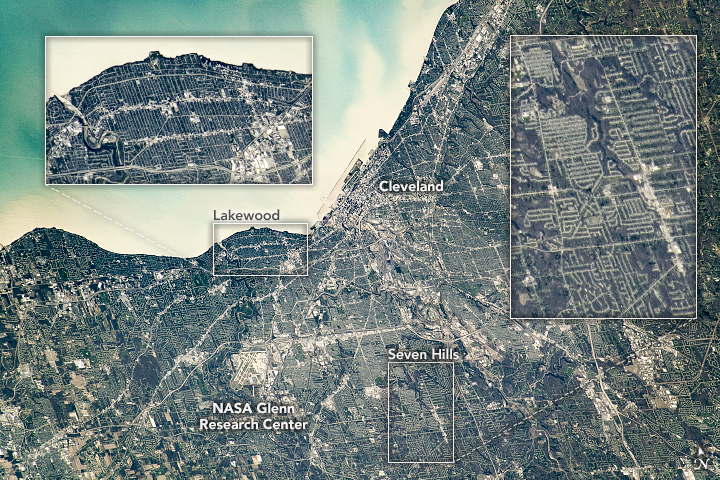Cleveland, Ohio, and its expansive suburbs stretch inland from Lake Erie in this slightly oblique photograph taken by an astronaut on the International Space Station (ISS). The metropolitan area’s layout has evolved as time and technology have advanced. From the perspective of the ISS, different urban neighborhoods and suburbs have distinct features based the era when they were developed and planned.
Throughout the 1800s, most Clevelanders lived, worked, and walked within the tight borders of Cleveland proper—today’s downtown area. The arrival of streetcars—first horse-drawn, then electric—allowed residents to live on the outskirts but still maintain an urban lifestyle. By the early 1900s, communities like Lakewood grew from this streetcar-fueled suburban revolution. The 1920s through 1940s paved the way for the next great transportation revolution and continuing suburban evolution. With automobiles in vogue, communities like Seven Hills developed even farther from the urban core.
In this photo, streetcar-based suburbs like Lakewood appear dense and grid-like, while automobile-based suburbs (Seven Hills)—less concerned with supporting a walking population—are more expansive and have flourishes like cul-de-sacs.
As the city advanced, it became an aviation hub. When the National Advisory Committee for Aeronautics (NACA) was searching for a location for a new aviation laboratory, Cleveland was a top choice. This lab, now NASA Glenn Research Center, will celebrate the 80th anniversary of its groundbreaking on January 23, 2021. Beyond the main campus, NASA built an advanced test facility at Plum Brooke Station, 50 miles (80 kilometers) away on the edge of Lake Erie (out of the frame to the west). In December 2020, Plum Brooke was renamed the Neil A. Armstrong Test Facility after the Ohio native, Moon-walking astronaut, and former Glenn employee. This facility is now playing a critical role in testing the Orion spacecraft that will return to the Moon in the Artemis program.
Astronaut photograph ISS062-E-121292 was acquired on April 16, 2020, with a Nikon D5 digital camera using a 500 millimeter lens and is provided by the ISS Crew Earth Observations Facility and the Earth Science and Remote Sensing Unit, Johnson Space Center. The image was taken by a member of the Expedition 62 crew. The image has been cropped and enhanced to improve contrast, and lens artifacts have been removed. The International Space Station Program supports the laboratory as part of the ISS National Lab to help astronauts take pictures of Earth that will be of the greatest value to scientists and the public, and to make those images freely available on the Internet. Additional images taken by astronauts and cosmonauts can be viewed at the NASA/JSC Gateway to Astronaut Photography of Earth. Caption by Alex Stoken, Jacobs, JETS Contract at NASA-JSC.
Article From & Read More ( From Automobiles to Armstrong - NASA )https://ift.tt/3quo26Z
Science

No comments:
Post a Comment